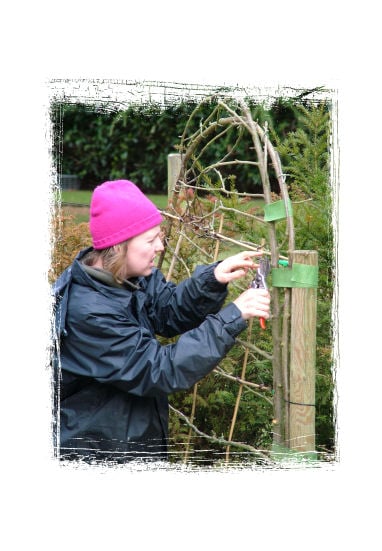Remember last month I brought you some updates of what we've been up to in our own Harrod Horticultural Kitchen Garden?
Well, our gardener Sharon's been busy once again - this time she's pulled on her woolly hat, dug out her secateurs and taken a crash course in the winter pruning of tree fruit!
Here's what she had to say...
There is a very steep learning curve when taking on a new garden, it takes a while to ‘find your feet’ in fresh surroundings and some tasks can be a little daunting.
One such task is pruning, especially challenging when it comes to several out of shape espaliers. All the gardening books I had studied had left me slightly confused and there is no substitute for hands on practical advice!
So I called in the help of Graeme Proctor, a chap with great credentials (in 1993 Graeme took over Crown Nurseries in Ufford, Gold medal winners at the Suffolk Show). Fortunately he was able to visit the garden and give Stephanie and I some indispensable tips.
First Step - Choice
When choosing trees for the garden it is essential to know exactly what you want to achieve, this is very important when creating espaliers, you need the right tree (and rootstock) for the job.
Location
Exposed, sunny, windy, spacious, tight, against a wall, freestanding or trained (maybe using one of our new kits), perhaps a post, wire and gripple combo.
Formation
Winter is a key time in espalier formation. Step by step you need to build a good framework (there is advice on this with our new espalier kit)
With Graemes help we trained our latest arrival, a new pear tree, using a classic Victorian shape, it should make a lovely feature and will be going to Chelsea to show off the new frame and handsome longtom.
Maintenance
Again ,Winter is an important time, using your trusty well sharpened Felcos, keep your trees happy by removing congested growth.
If dealing with an espalier remove ‘Laterals’ below tiers when necessary and prune back horizontal arms/laterals (remember a clean slanted cut above a growth bud) The RHS books are helpful for reference.
Take a step back! Look and try to bear in mind the natural inclination of a trees growth. Trees want to grow and reproduce, you want a particular shape. A balance can be achieved by the removal of the Apical bud (that’s the big one on the end of the branch/lateral) this stimulates growth further back down the laterals as the tree tries to replace its ’kingpin’ apical bud.
The sap wants to flow up and away to the end bud, you can interrupt this flow by raising or lowering stems and ‘Nitching and Notching’
A Nitch - is made above the bud, that is between the bud and the apical. It is done to promote a dormant bud to leaf and then create spurs on which the tree will bear fruit. Useful for filling bare or bald spaces.
A Notch - is made under the bud (away from the apical) to promote a bud to fruit. You do not want a fruit bud directly on a main arm or lateral, instead you need to create a strong framework of spurs on which the fruit will be borne.
The Tina combination knife is perfect for this, I sharpened mine using our resident tool maintenance kit, you need a really fine sharp edge to make those little ‘smile’ shaped cuts only as wide as the bud.
You could also take the time to retie, Graeme was particularly impressed with the soft tie I was using for the job, this is one product I have found indispensable in the garden.
Remember Summer is the main time for pruning trained forms of tree, you need to encourage the formation of fruiting spurs by chopping back laterals off the main arms/stems to 3 leaves or 3 or 4 buds and side shoots to one leaf. Again refer to the RHS books for help.
So, armed with all this new knowledge I have been busily working my way round the garden. Sometimes things get drastic (we had to remove to a sickly peach and a nectarine tree, both suffering from canker, shade and wind exposure)
I am holding my nerve and following all Graemes advice including ’Garlic Spraying’ all the trees to guard against aphid attack.
On I go, with plenty to do at this busy time of year in the kitchen garden.
UK Manufacturing since 1954



























